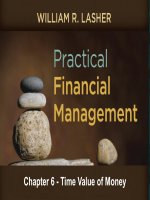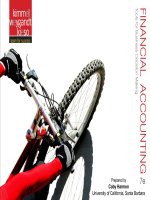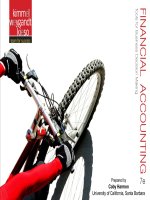Practical financial managment 7e LASHER chapter 16
Bạn đang xem bản rút gọn của tài liệu. Xem và tải ngay bản đầy đủ của tài liệu tại đây (593.25 KB, 65 trang )
Chapter 16 Working Capital
Working Capital Basics
Working Capital
– Assets and liabilities required to operate a business on a day-to-day
basis
Assets:
– Cash
– Accounts Receivable
– Inventory
Liabilities:
– Accounts Payable
– Accruals
2
Working Capital, Funding Requirements, and the Current Accounts
Gross Working Capital represents an investment in assets
– Capital – funds committed to support assets
– Working – short term, day-to-day operations
Working Capital Requires Funds
– Maintaining a working capital balance requires a permanent funds
commitment
3
The Short-Term Liabilities
Spontaneous Financing
Operating activities automatically create payables & accruals essentially debts
– These liabilities spontaneously offset the funding required to support
current assets
4
Working Capital and the Current Accounts
Net Working Capital – the difference between gross working
capital and spontaneous financing
Generally:
– Gross working capital = current assets
– Net working capital =
current assets – current liabilities
People often say working capital when they actually mean net working
capital
5
Objective of Working
Capital Management
To run the firm with as little money tied up in the current accounts
as possible
Working capital elements
– Inventory
– Receivables
– Cash
– Payables
– Accruals
6
Objective of Working Capital Management
Inventory
High Levels
Low Levels
Benefit:
Cost:
Happy customers – supplied quickly
Shortages
Few production delays (parts always on hand)
Dissatisfied customers – product not available
Cost:
Benefit:
High financing costs
Low financing and storage costs
High storage costs
Less risk of obsolescence
Shrinkage (theft)
Risk of obsolescence
Cash
High Levels
Benefit:
Reduces risk of being unable to pay bills
Cost:
Increases financing costs
Low Levels
Benefit:
Reduces financing costs
Cost:
Increases transaction risk
7
Objective of Working Capital Management
Accounts Receivable
High Levels
Low Levels
Benefit:
Cost:
Happy customers –can pay slowly
Customers unhappy with payment terms
High credit sales
Lower Credit Sales
Cost:
Benefit:
More bad debts
Less financing cost
High collection costs
Increased financing costs
Payables and Accruals
High Levels
Benefit:
Spontaneous financing reduces need to borrow
Cost:
Unhappy suppliers because paid slowly
Low Levels
Benefit:
Happy suppliers/employees
Cost:
Not using spontaneous financing
8
Figure 16-1 Cash Conversion Cycle
9
Figure 16-2 Timeline Representation of Cash Conversion Cycle
10
Permanent and Temporary
Working Capital
Need for working capital varies with sales level
Temporary working capital supports seasonal peaks in business
Working capital is permanent to the extent that it supports a
constant, minimum level of sales
11
Figure 16-3 Working Capital Needs of Different Firms
12
Financing Net Working Capital
Short-term working capital should be financed with short-term
sources
Maturity Matching Principle – the term of financing should match
the term or duration of the project or item supported
13
Short-Term vs. Long-Term Financing in Support of Working Capital
Long-term financing
Short-term financing
Safe but expensive
–
Safe – funds are committed and
Cheap but risky
–
can’t be withdrawn
–
Expensive - long-term rates are
generally higher
Cheap - short-term interest rates are
generally lower
–
Risky - must continually renew
borrowing
14
Alternative Financing Policies
The mix of short/long-term financing supporting working capital
– Heavier use of longer term funds is conservative
– Using more short-term funding is aggressive
15
Figure 16-4a Working Capital
Financing Policies
16
Figure 16-4b Working Capital
Financing Policies
17
Working Capital Policy
A firm’s Working Capital Policy refers to its handling the following
issues:
– How much working capital is used
– Extent supported by short or long term financing
– The nature and source of any short-term financing used
– How each component is managed
18
Sources of Short-term Financing
Spontaneous financing
– payables and accruals
Unsecured bank loans
Commercial paper
Secured loans
19
Spontaneous Financing
Accruals
–
Accounts Payable
Interest–free loans from
–
whoever provides services
deferring payment
–
Wage Accrual
Effectively loans from suppliers selling
on credit
–
Credit Terms:
Specify details of payment
Money owed to employees for
E.g. 2/10, net 30
work performed but not yet paid
2% discount if pay within 10 days,
otherwise entire amount due in 30 days
20
Prompt Payment Discount
Passing up prompt payment discounts is an expensive source of
financing
If terms are 2/10, net 30, and don’t pay by the 10th day,
essentially paying 2% for 20 days’ use of money
The implied annual rate is
(365 / 20) x 2% = 36.5%
21
Abuses of Trade Credit Terms
Trade credit, originally a service to customers, is now expected
– Paying beyond the due date is a common abuse of trade credit
Called “stretching” payables or “leaning on the trade”
Slow paying companies receive poor credit ratings
–
May lose the ability to buy on credit in future
22
Unsecured Bank Loans
Represent the primary source of short-term financing for most
companies
Unsecured Repayment is not guaranteed by the pledge of a
specific asset
Promissory Note – Written promise to repay amount borrowed
plus interest
23
Unsecured Bank Loans
Line of credit
– Informal, non-binding agreement between a bank and a borrowing
firm specifying the maximum amount that can be borrowed during a
period
24
Revolving Credit Agreement
Similar to a line of credit except bank guarantees availability of
funds up to a maximum amount
– Borrower pays a commitment fee on the unborrowed balance
25









